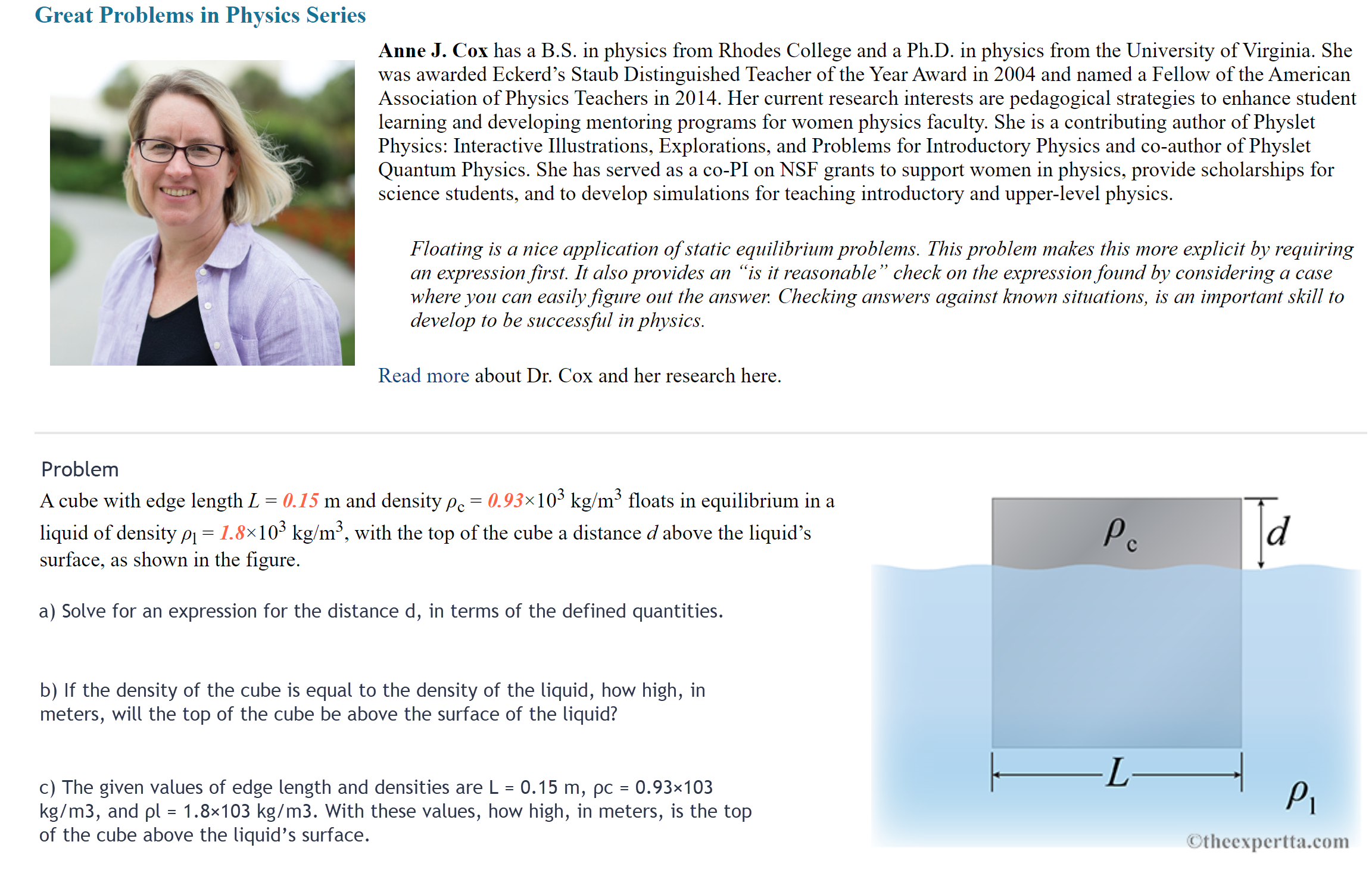A Simple Idea to Encourage Underrepresented Groups in STEM
Instructors assign homework throughout the semester. Why not use this as a vehicle “… to highlight the accomplishments of diverse STEM professionals, to help strengthen feelings of STEM belonging.”1 We are creating a series of “Great Problems” for STEM subjects like physics, biology, astronomy, chemistry, calculus,… and invite you to participate.
These collections of problems, such as the example below, will be made available for download and free to use by all. Click here to access the current Great Problems in Physics collection. We encourage educators to read the Potential Impact section below and to consider incorporating these problems, or problems like them, into their courses.
Those who would like to contribute to any of the collections would ultimately need to provide,
- a picture of yourself
- a short biography
- either submit one of your favorite problems or select one from the Expert TA library or from one of the OpenStax titles.
Use the form to the right to establish contact with us if you would like to be part the initiative.
Great Problems in STEM Series
At Expert TA, we understand the importance of Diversity in STEM and are working in many ways to help with this important societal problem.
The Research: Across a student’s life there are many points where an individual who might become a scientist decides not to. Research shows that a major factor for many women and students from underrepresented groups, is a feeling that science, engineering, and math just isn’t a place for them.
One recurring theme from the research is the importance of students being mentored by and seeing successful examples of people of their same gender and ethnicity. This theme was the inspiration for our “Great Problems” series.
Our Vision: Educators all have favorite problems that they assign or work in class, that help illuminate a key concept. For introductory classes in STEM subjects, imagine having a large enough collection of these “best” problems to cover every topic in the course. These are structured like the example below, where they are presented by an instructor/teacher/graduate student. The overview includes a picture, a short bio., and an explanation from the individual as to why the problem is such a good one.
The Potential Impact Imagine a student from an underrepresented group with potential and talent, who takes an introductory physics course and by the end has come to the conclusion that science doesn’t seem like the place for them. What if each week one of the problems in their assignment looked like the problem below? Perhaps the accumulation of seeing someone like them, who has been successful in that field, might result in them completing the class more encouraged about being a scientist instead of less.
Our Invitation: Our Great Problems in Physics collection is underway, and we have begun to create collections for other subjects. We encourage faculty, graduate students, teachers, etc. to consider being part of the initiative.
Using the Problems: These problems/questions are free to use and we encourage educators to do so. They are designed to be “problems that every student should work” so they should be easy to incorporate into your weekly assignments.

Recommendations from the Literature:
[1] “[We] should focus on inclusive learning by highlighting the accomplishments of diverse STEM professionals, to help strengthen feelings of STEM belonging.”
Kricorian, K., Seu, M., Lopez, D. et al. Factors influencing participation of underrepresented students in STEM fields: matched mentors and mindsets. IJ STEM Ed 7, 16 (2020). https://doi.org/10.1186/s40594-020-00219-2
[2] “We should highlight the important contributions of scientists who are from groups that are underrepresented in STEM.”
Killpack, Tess L., and Laverne C. Melón. “Toward inclusive STEM classrooms: what personal role do faculty play?.” CBE—Life Sciences Education 15, no. 3 (2016): es3.
[3] “These efforts to diversify the imagery of scientists must be repeatedly and meaningfully embedded into the fabric of the course to effectively update students’ stereotypical views (Bodzin and Gehringer, 2001) and to communicate to our multidimensional students that they belong in STEM.”
Killpack, Tess L., and Laverne C. Melón. “Toward inclusive STEM classrooms: what personal role do faculty play?.” CBE—Life Sciences Education 15, no. 3 (2016): es3.
[4] “Academic departments should recruit senior women in STEM fields to present their technical work as part of department colloquia, brown-bags, and other special events, providing opportunities for these speakers to meet and mentor students.”
Dasgupta, Nilanjana, and Jane G. Stout. “Girls and women in science, technology, engineering, and mathematics: STEMing the tide and broadening participation in STEM careers.” Policy Insights from the Behavioral and Brain Sciences 1, no. 1 (2014): 21-29.
[5] “… it is also important to develop efforts to change the perceptions of those currently considered to be members of the ingroup to broaden the prototype of who pursues STEM courses and careers. In this way, female students will not get marginalized from STEM environments. Recently on popular social media sites, we found women of various racialethnic backgrounds posting photos with the hashtag #ILOOKLIKEANENGINEER. Hashtags such as this one reflect the efforts put forth by women and individuals of color to change the prototype of what engineers or scientists and mathematicians look like. When such hashtags and efforts are no longer a trend is when we will know that young women are truly part of the STEM ingroup.”
Kim, Ann Y., Gale M. Sinatra, and Viviane Seyranian. “Developing a STEM identity among young women: A social identity perspective.” Review of Educational Research 88, no. 4 (2018): 589-625.
